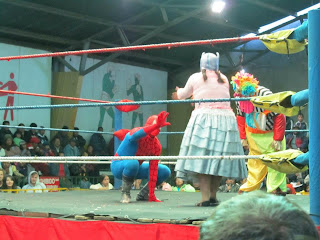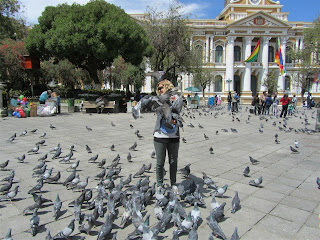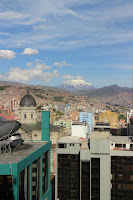For more pictures see facebook
 As I mentioned at the start of the last blog we spent a few days in La Paz before heading South to the Town of Uyuni and the largest salt flat in the world. La Paz is the seat of Government and is the economic hub of Bolivia but Sucre is still technically the capital. However, for all intensive purposes La Paz is the capital and is often referred to as the highest altitude capital in the world.
As I mentioned at the start of the last blog we spent a few days in La Paz before heading South to the Town of Uyuni and the largest salt flat in the world. La Paz is the seat of Government and is the economic hub of Bolivia but Sucre is still technically the capital. However, for all intensive purposes La Paz is the capital and is often referred to as the highest altitude capital in the world.
Cholitas wrestling
We stayed in a nice hostel with pancake breakfasts (nice change from stale bread with butter and jam), near the bus station and a short walk from the centre of town. On the first evening having literally just arrived at the hostel we were bustled into a tourist minibus and taken to see La Paz´s Cholitas wrestling. Bolivians are crazy about wrestling and you will often see hordes of men standing around a small television set on one of the street stalls watching play backs, the Cholitas wrestling however is unlike anything we had ever seen.
It started tamely enough with a few masked wrestlers, playing good versus evil, doing the rounds but soon it evolved into elaborately dressed females in traditional clothes throwing each other into the crowd and hitting each other over the head with metal fences.Of course it is all staged and at this level blindingly obvious but it was still fascinating to watch. The local really got involved and were often more entertaining than the wrestling, booing at the baddy and throwing oranges and pop corn into the ring.
La Paz – the history lesson 🙂
After the craziness of the Cholita wrestling we just chilled out for the rest of our few days in La Paz and just spent time getting lost and enjoying the great city. The Spanish ruled La Paz, as with all of the Americas, with an iron fist. The city was divided up into separate areas for each of the threes classes with existed within the city ; the Spanish born population were the privileged class and lived in the largest houses in the grandest part of town, the middle class were the Criollo, who were o Spanish descent but were born in the Americas and therefor not as pure, and lastly at the bottom of the pile were the indigenous people.
Because of this distinction the old town of La Paz is an interesting mixture of grand old villas and squares complete with more pigeons than you can imagine, and small meandering cobbled streets and tightly packed terraced houses. The indigenous people did revolt in 1781, barricading the entry ways into the Spanish part of town creating a siege which lasted 6 months. Help however eventually arrived from other colonial towns and the Spanish, who lived in such fear of a loss of power, almost completely obliterated the indigenous population of La Paz in retribution.
In the end independence for Bolivia and the rest of Central and South America was secured not by the local population who were technologically disadvantaged compared to the Spanish but by the Criollo who were sick of being treated as second class citizens. Bolivia gained its Independence in 1825 but it did not result in equal rights for all. The indigenous population still suffered and still fight for great rights. Evo Morales, the current president, was elected 2005 and is the first indigenous president of Bolivia. Great improvements have been made but like in many other countries differences in socio economic status are difficult to fix.
Good Bye McDonalds
While La Paz is slowly but surely joining the 21st Century one thing that has not changed is the tradition of shopping at the markets instead of heading to the closest Tesco. The locals say they love to haggle and barter over prices and prefer the social element of visiting the different stalls each week rather than going to the shopping centre. This market culture is also the reason why McDonalds pulled out of Bolivia in 2002. They couldn´t compete with the small food stalls who could offer a hamburger for a quarter of the price or offer a four course meal complete with a dessert for half the price of a happy meal.
Lanza, one of the largest indoor markets in La Paz, is a maze with numerous floors. Each floor has different products for sale such as meat on the ground floor, fruit and veg on the floor up, next household and then on top the small food stalls. The stalls are set up like small metal containers, open on both ends with a small kitchen along one end and seating along the other. We ended up going into a place where the woman had an obvious obsession with the colour pink and had turned her stall into a miniature dolls house.The food was good though and we walked out having spent just over one NZ dollar on our lunch.
The Witches Market
The Witches Market was another fascinating place we visited where traditional Inca beliefs and Catholic beliefs blur. Offerings to Pacha Mama (Quechua for Mother Earth) are still made and locals head to the witches market for supplies for most ceremonies. Llama foetus´are seen hanging in front of many stalls, which must be buried in the foundations of any new house as a sacrifice to keep the builders safe during construction. It is said that for larger projects a greater sacrifice is needed and many homeless people are rumoured to have disappeared, thought to be buried in the foundations of large public works!
The Spanish took advantage of these superstitions to convert the local people to Christianity. The indigenous people believed that if you looked into a mirror you lost your soul so the Spanish built impressive, elaborate churches and surrounded the alters with mirrors so that the people would have to keep returning in an effort to retrieve their lost souls. And it worked, Bolivia is now over 90% Catholic.
San Pedro Prison
One of the most interesting things that we did while in La Paz was go on the Free City Tour. The walking tour started outside San Pedro prison made famous by the book Marching Powder. Once open for tours, the authorities have since closed them all down so now the closest you can get is the square outside. The prison as once a convent and because of its unusual layout, complete with four internal squares, it is organised in a very different way to most prions. Prisoners must pay for their own room and as many families cannot afford double rent they all move into the prison to live with their father. The 200 children who live in the prison attend school outside of the prison each day returning to the prison every evening. Inside the prison hairdressers, shops and restaurants exist with Coke Cola owning the advertising rights and supplying chairs, tables and umbrellas for the restaurants. The prison guards are only slightly involved in the control of the prison and each of the areas surrounding the four squares elected a leader and abide by a set of rules imposed by the prisoners. Most of the prisoners are in their for drug crimes and as such some of the best cocaine in the world is rumoured to come out of the prison. While the system seems crazy it seems to work. Bolivia in general appears to operate in a permanent state of organised chaos, but things do get done, live does go on and life is slowly becoming better.








